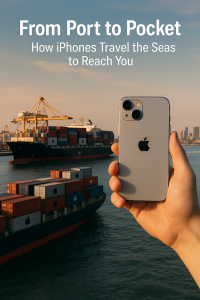Discover how iPhones journey from factories in Asia to your hand through global maritime logistics. A fascinating look at the role of ships, ports, and maritime professionals in Apple’s supply chain.
🌍 Have You Ever Wondered How Your iPhone Gets to You?
When you unbox a new iPhone, you’re holding a marvel of technology. But behind the sleek glass and aluminum is another marvel—a global maritime logistics network that transports components and final products across oceans, continents, and ports. This article explores the vital role maritime shipping plays in moving Apple’s flagship product from its origin to your pocket.
⚓ Key Concepts: Understanding the Maritime Link in Apple’s Supply Chain
What is Maritime Logistics?
Maritime logistics refers to the process of planning, executing, and managing the movement of goods across international waters using ships. For large multinational companies like Apple, maritime logistics is the backbone of global distribution.
Why Shipping Matters for Tech Giants
-
Cost Efficiency: Sea freight is more economical for bulk transport compared to air freight.
-
Capacity: Ships can handle massive volumes of iPhones and components.
-
Sustainability: Modern vessels are becoming greener, aligning with corporate environmental goals.
🚢 The Journey of an iPhone: From Factory Floor to Your Front Door
1. Manufacturing in China
Most iPhones are assembled in Zhengzhou, China—nicknamed “iPhone City.” Parts come from over 40 countries, but the final assembly is typically done here by companies like Foxconn.
2. Departure from Chinese Ports
Finished units are packed into containers and loaded onto cargo ships at major ports like Shanghai, Yantian, or Ningbo-Zhoushan.
3. Crossing the Seas
The cargo vessels—often operated by shipping giants like Maersk, COSCO, or CMA CGM—sail through critical trade routes such as:
-
South China Sea
-
Malacca Strait
-
Indian Ocean
-
Suez Canal (to Europe) or Panama Canal (to the Americas)
4. Arrival at Destination Ports
Examples of arrival ports include:
-
Port of Los Angeles/Long Beach (USA)
-
Port of Rotterdam (Europe)
-
Port of Singapore (Asia distribution)
5. Last-Mile Distribution
Once offloaded, iPhones travel by rail or truck to regional distribution centers, then finally to retail stores or directly to consumers.
⚙️ Maritime Technologies Behind the Scenes
Apple benefits from innovations in the maritime industry, including:
-
Automated container tracking systems
-
Blockchain-based shipping documentation
-
Eco-efficient vessels
-
Digital twins for ship monitoring
For more on ship innovation, see our article on Ship Machinery and Systems.
🌊 Global Ports and Maritime Workforce: A Vital Connection
The iPhone’s journey wouldn’t be possible without:
-
Port workers ensuring fast unloading
-
Marine engineers maintaining the ship’s propulsion
-
Ship officers navigating complex sea routes
-
Customs officials handling regulatory paperwork
Students interested in such roles can read our guide on How to Start a Career in Maritime.
📈 Latest Trends & Future Outlook
-
Green Shipping: Apple and its partners are exploring carbon-neutral shipping options.
-
AI and IoT in Ports: Smarter port operations mean quicker unloading and turnaround times.
-
Decentralized Supply Chains: Apple is diversifying production across other Asian countries and India, impacting future maritime routes.
✅ Conclusion: Maritime—The Unsung Hero Behind Every iPhone
Your iPhone’s journey from “port to pocket” is a testament to the incredible coordination between global manufacturing and the maritime world. Every swipe, tap, and call on your device is powered not just by technology—but by ships, ports, and maritime professionals who keep global trade flowing.
📚 FAQs
Q1: How long does it take for iPhones to be shipped by sea?
A: It depends on the route. From China to the U.S. West Coast, it can take 14–20 days by sea.
Q2: Why doesn’t Apple use air shipping?
A: While faster, air freight is significantly more expensive and less efficient for mass-scale deliveries.
Q3: What happens if there’s a port delay?
A: Port congestion or strikes can delay shipments by days or weeks, impacting global availability and pricing.


